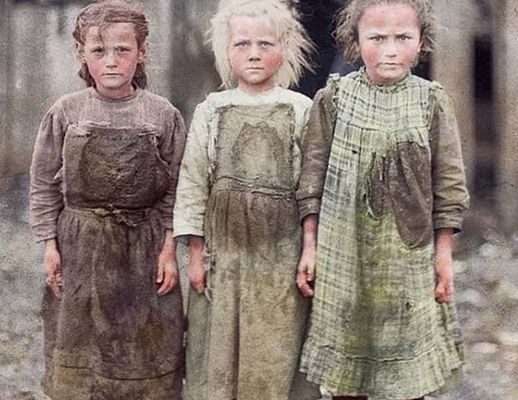At first look, this picture seems like just another old photo from long ago—three young girls, looking like they belong to a different time, standing in a seaside town. Their clothes are faded, their faces show signs of weariness, and the place around them looks pretty bare.
However, if you look deeper, there’s a story that stretches beyond what you see, a tale that reflects the challenges and sacrifices of a generation that has been forgotten by time.
This isn’t just a picture; it’s a glimpse into a time when kids had to give up their childhood to help their families survive, where the joy of being young was hidden by the hard work they had to do.
Come along as we uncover the story behind this famous picture, looking into the lives of three young girls who are facing the tough situation of child labor.
What the image portrayed

In this picture, there are three girls: Josie and Bertha, who are both six years old, and Sophie, who is ten. They are busy shucking oysters, which is pretty hard work. They are working at the Maggioni Canning Co., a place where it was normal for kids to have jobs.

These girls were among many other child workers who had to work hard to help their families, which often meant they had to give up their education and health.

The picture shows how tired they are, highlighting how common this tough situation was, where they worked long hours in risky conditions for just a little bit of money.
The making of the photo

The Library of Congress says that this touching photo was captured in February 1912 by Lewis Wickes Hine. He was a sociologist and photographer who spent a lot of his life showing the terrible conditions that children faced while working in the United States.

Hine’s art wasn’t just about taking pictures; it was about revealing the stories that those in charge wanted to stay secret.

He played a huge part in changing child labor laws because his pictures really moved people and helped bring about important new laws.

Hine frequently had to wear different costumes to take these pictures.

Hine faced serious risks when showing the harsh truths about child labor, so he would often pretend to be a Bible seller, a postcard seller, or even a photographer taking pictures of factory machines.

This photo was snapped in Port Royal, South Carolina, and it’s part of Hine’s larger project that covered areas from the Northeast all the way to the Deep South, showing what life was like for child workers in various jobs.

The Maggioni Canning Co. was one of several businesses that hired kids like these girls to do jobs.

It’s pretty cool that the company is still running today, even though things are way different now.
The child labor before reform

Before the Fair Labor Standards Act was passed in 1938, many children, including Josie, Bertha, and Sophie, faced terrible working conditions and were often taken advantage of.

They toiled in tough situations, putting in long hours in dangerous places and earning very little money.

The Industrial Revolution brought a lot of money and growth, but it also had a heavy price. Many children had to work in tough jobs that made them really tired and took away their chance to go to school.

These situations were not only risky but also cruel, keeping families stuck in a never-ending cycle of being poor.

Lewis Hine’s amazing photos reveal the harsh truths about child labor, highlighting how important it is to make changes. His efforts played a key role in getting laws passed to keep children safe from this kind of terrible treatment.

Nowadays, we’ve come a long way, but Hine’s pictures still show us how crucial it is to protect the rights and happiness of kids all around the world.



